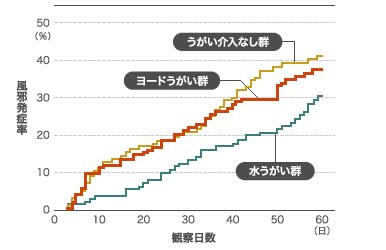Source
Department of Public Health and International Health, Kyoto University School of Public Health, Kyoto, Japan.
Abstract
BACKGROUND:
Gargling to wash the throat is commonly performed in Japan, and people
believe that such hygienic routine, especially with gargle medicine, prevents
upper respiratory tract infections (URTIs). Its effectiveness, however,
has not been established by clinical trials.
DESIGN:
Randomized controlled trial carried out in 2002-2003 winter season and
analyzed in 2003 and 2004.
PARTICIPANTS:
Healthy volunteers (387) aged 18 to 65 years.
INTERVENTION:
Participants were randomly assigned to water gargling, povidone-iodine gargling, and usual care (control). Subjects in the two gargling groups were requested to gargle with water or diluted povidone-iodine at least three times a day. Participants were followed for 60 days.
MAIN OUTCOME MEASURES:
he primary outcome measure was first URTI incidence. Severity of URTI symptoms
among incident cases was also evaluated. Both outcomes were assessed with
a self-administered symptom record. Analyses were performed on an intention-to-treat
basis.
RESULTS:
A total of 130 participants contracted URTIs. The incidence rate of first
URTI was 0.26 episodes/30 person-days among control subjects. The rate
decreased to 0.17 episodes/30 person-days in the water gargling group,
and 0.24 episodes/30 person-days in the povidone-iodine gargling group.
Respective incidence rate ratios against controls were 0.64 (95% confidence
interval [CI]=0.41-0.99) and 0.89 (95% CI=0.60-1.33). A Cox regression
(proportional hazard model) revealed the efficacy of water gargling (hazard
ratio=0.60, 95% CI=0.39-0.95). Even when a URTI occurred, water gargling
tended to attenuate bronchial symptoms (p=0.055).
CONCLUSIONS:
Simple water gargling was effective to prevent URTIs among healthy people.
This virtually cost-free modality would appreciably benefit the general
population.
